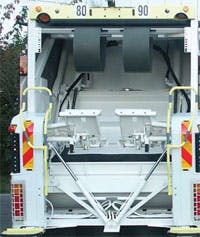Faun Environment, Guilherand Granges, France, builds Variopress rear loading refuse collection trucks that can clear 1000 dumpsters of waste a day. The automatic lifter can empty bins of up to 82 gal in only 8 sec, and it takes only 11 sec to discharge 290- gal bins. A big reason for this high productivity is automated operation, made possible, in part, by in-cylinder magnetostrictive linear displacement transducers (LDTs) from MTS Systems, Cary, N. C.
The Variopress is a versatile machine that can handle a large variety of containers in differing shapes and sizes from 21 to 290 gal. The Variopress uses Faun’s Twinlift hydraulic lifting and discharging system that ensures speedy truck filling using a fully automated lifting system. Smaller bins can be lifted by using just one of the lifter units.
This configuration improves productivity by allowing both lifts to operate simultaneously, yet independently. Typically, this added productivity is gained by sacrificing the ability to handle larger bins that require the lifting capacity of a larger single-lift design. However, the Twinlift design solves this problem by synchronizing the hydraulics of both lifts through elect rohydraulic motion control.
The parallel operation of the lifter units requires synchronizing the hydraulic cylinders while lifting, discharging, and lowering the larger cont a ine r. MTS sensors are used in this function to monitor the lifting cycle. Each hydraulic cylinder in the lifter units is fitted with an embedded sensor that feeds stroke position information back to the controls for controlling electro-hydraulic valves.
The speed of the cylinder changes with stroke position, making accurate position and quick response essential. Knowing the cylinders’ position allows the electrohydraulic controls to accelerate and decelerate the cylinders as their pistons approach the end of their stroke. This type of control prevents high impacts and pressure spikes that otherwise would occur from the cylinder bottoming out at the end of stroke. This prolongs service life, and also reduces noise considerably because the cylinders are no longer impacting at the end of stroke.
The magnetostrictive solution
Because precise motion control is critical for safe parallel guidance of the lifting units, the output of the sensor must be consistent even under the harshest environmental conditions. Empirical testing has proven that high accuracy of the magnetostrictive sensors is also a fundamental requirement for even discharge control, in particular, if the container has an uneven load distributed across the synchronized cylinders.
MTS’ MH sensor, designed specifically to be embedded in hydraulic cylinders, provides high reliability, immunity to interference, and accuracy when compared to other solutions. Additionally, magnetostrictive technology does not require direct contact between the position magnet and the sensing element, eliminating any points for wear. Designed for cylinders with a bore of at least 2 in., the MH sensor measures strokes from 2 to 98 in. while maintaining high accuracy and repeatability.
“Municipal refuse collection vehicles are increasingly employing intelligent sensors to increase productivity, safety, and work quality,” states Brian Cox, MTS’s technical marketing manager, mobile hydraulics. “Sensors in these vehicles are constantly subjected to harsh and unforgiving conditions including high shock and vibration, stone impact, various environmental conditions, and electromagnetic interference.”
For more information on the MTS Sensors Group and mobile hydraulic position sensing, contact: Brian Cox at (919) 677-0100, e-mail brian.cox@mts. com; or visit www.mtssensors.com.


